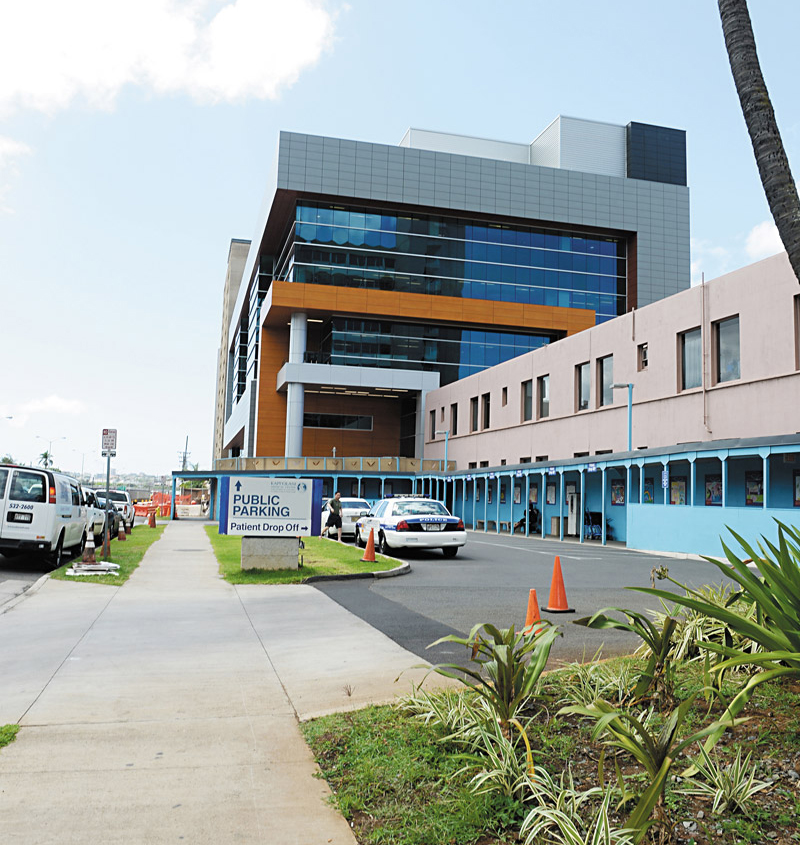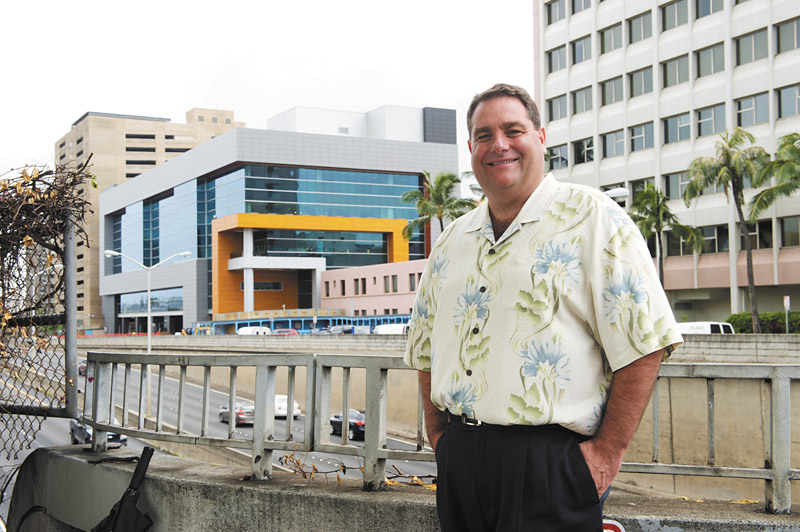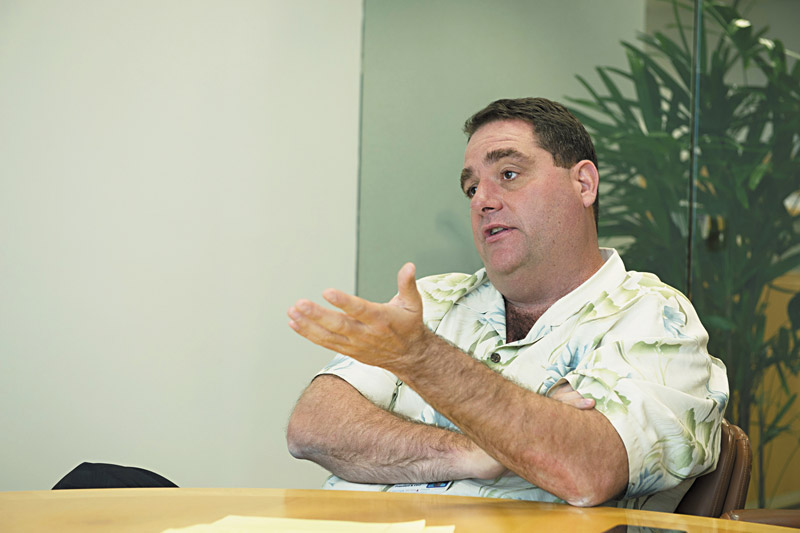Putting The Health In Health Care
Esteemed newsman Walter Cronkite once declared, “America’s health care system is neither healthy, caring nor a system.” He evidently never met Ray Vara, president and chief executive officer of Hawaii Pacific Health.
Healthy, caring and systematic are maxims that define Vara as a steward of wellness in our state.
Leading Hawaii’s largest health care provider, he administers the productivity and prosperity of four major hospitals — Kapiolani, Pali Momi, Straub on Oahu and Wilcox on Kauai — plus 70 affiliated clinics.
It’s a mighty task at a time when the industry is in massive disruption.
The American health care system is said to be the most complex and bureaucratic in the world — and the most expensive. The United States ranks last among 11 industrialized nations on measures of health system quality, efficiency, access to care, equity and healthy lives, according to Commonwealth Fund, an independent research foundation.
We spend $2.8 trillion on health care annually, according to industry statistics. That works out to be about one-sixth of the total U.S. economy and more than $8,500 per person — way more than any other country.

Vara Says 90 Percent Of Waste From Construction Of Kapiolani’s New Neonatal-Pediatric Intensive Care Center Is Being Repurposed
If the health care system were its own economy, it would be the fifth largest in the world.
Asked to characterize health care, Vara replies, “It’s an industry in great transition and distress as it tries to bridge the gap between providing quality care and payment reform.
“What we fundamentally believe is no matter what legislative mandates (such as the Affordable Care Act aka Obamacare) are imposed, we need to make a shift from volume-based payment to value-based care,” he continues.
“We need to get to a place where an empty bed is as equally valued as an occupied one,” he says. “The basic question then changes from, ‘What’s the matter?’ to ‘What matters to you?’
“Our physicians, colleagues and paying partners stand alongside us to lead that change.”
Analysts say medicine is becoming a spectator sport. Doctors, nurses and patients perform before an enlarging audience of utilization reviewers, efficiency experts and cost managers.
Vara knows this scenario well and has notches in his career belt to prove it.
Prior to joining Hawaii Pacific Health in 2002, he was chief executive officer for Los Alamos Medical Center in New Mexico. Before that, he was the center’s chief financial officer.
From 1988 to 1998, he served as a U.S. Army officer with various assignments, including assistant administrator and chief financial officer for Bassett Army Community Hospital in Fairbanks, Alaska, and deputy chief financial officer for Madigan Army Medical Center in Tacoma, Washington. He served with the 9th infantry regiment, Fort Lewis, Washington, and Tripler Army Medical Center in Honolulu.
Vara has a bachelor’s degree in business administration from Hawaii Pacific University and an MBA from University of Alaska at Fairbanks. He is a member of American College of Healthcare Executives and serves on several local and national boards.
Equally important are his personal credentials as husband and father to four children, whom he raised in Hawaii so they would benefit from a pristine environment and healthy lifestyle.
“It’s all about contributing to an organization that makes an impact in the community,” he says of his job. “What we do is very personal to me.”
That alignment of personal and professional values also resonates with the nearly 7,000 employees of Hawaii Pacific Health (HPH).
“Our very best work is when we are working together,” Vara says. “But our mission today is even greater.
“We are championing quality and not quantity,” he explains. “We are transforming health care by partnering with physicians, health plans and the community, and doing so by focusing on prevention, early intervention and regular checkups. In effect, we are working hard to create a healthier Hawaii.”
Ding, ding, ding. That sounds like a good branding slogan.
As a matter of fact, “Creating a Healthier Hawaii” is the mantra that will drive a greater-good mission for HPH from now on.
It was launched June 5 with an eye-catching two-page ad with every employee’s name in Honolulu Star-Advertiser. You see the new slogan on the redesigned website (hawaii-pacifichealth.org) and, with a new logo type, it will roll out in all system communications and collateral material.
“Our new branding is really catching up to the work we’ve been doing all along,” says the 47-year-old Ohio-born executive. “Work has gotten ahead of how we identify ourselves and the impact we’ve made in the community.
“Creating a healthier Hawaii is the central promise of our new marketing campaign,” he heralds.
It also elevates the mission of HPH to a noble cause based on what Vara says are “the social determinants of health” and “population health.”
OK, don’t get lost in the new buzzwords. We’re not here to cause you pain.
There comes a time in the life of an institution, particularly with legacy members like Kapiolani Medical Center for Women & Children (since 1945), Pali Momi Medical Center (1989), Straub Clinic & Hospital (1921) and Wilcox Memorial Hospital (1938), when its mission and vision must aspire higher.
Essentially, this means that, for individuals to have quality care, the quality of life around them must be optimal as well. Vara gives us an example.
“Right now, 30 percent of HPH patients come from the homeless population,” he reports. “They stay in the hospital on the average 30 percent longer than other patients. From what we’ve observed, they die on average about 30 years younger than the rest of us.”
This has obvious social and economic implications conscionable organizations like HPH no longer can ignore.
“You’ll see us involved in educational programs beyond health education,” he says. “You’ll see us involved in addressing issues such as homelessness and environmental stewardship.
“Look at the project at Kapiolani,” he cites. “Ninety percent of the waste from its construction project is being repurposed. We have an 800-kilowatt solar farm at Wilcox, the largest installation on Kauai and at any hospital in the state. Straub and Pali Momi already have LED lighting, resulting in significant cost savings.
“Health starts in our homes, schools, workplaces, neighborhoods and communities,” Vara asserts.
That’s the big picture and why HPH is embracing its social responsibility mission. There’s no way to promote individual wellbeing if one’s living in an unhealthy environment. One must address social ills along with individual health.
“We, as an organization, have the responsibility to provide leadership and work with others, inside and outside of health care, to address social determinants,” he says. “It requires partnership and energy from like minds.
“We’re one of the largest non-governmental employers in Hawaii. We’re also one of the largest revenue producers, so we’re at the tip of the spear, in terms of being able to make a meaningful impact. We don’t just get to sit on the side.”
Understand that a parent company like HPH is not the entity that treats patients. That role belongs to the medical professionals of doctors and nurses at hospitals and clinics. HPH, a not-for-profit network, administers and manages the business to relieve medical staff of overhead, marketing and nonclinical tasks.
It ensures that the infrastructure of care services is in good shape for today and tomorrow. That includes modernizing facilities like Kapiolani, currently in the midst a multiphase redevelopment of its hospital and critical-care wings. A new five-story tower on Bingham Street houses 70 state-of-the-art neonatal intensive care and 14 pediatric intensive care units. Affectionately referred to as NICU-PICU, the departments grew from 10,000 to 50,000 square feet, allowing private room configurations.
Community open house is set for July 16 from 1 to 3 p.m. The modern building stands in stark contrast to older structures that eventually will be razed to expand the nonprofit hospital for women and children to 450,000 square feet.
The new skyline off Punahou Street makes a strong visual statement of what HPH is doing to prepare for the next generation of providers and patients.
As practical as Vara is, his visionary sense constantly must search for perfection beyond today.
We ask him to describe a health care utopia.
“The ideal health care system would be a true system of care in which individuals and their loved ones would have all the information and resources they need to live the healthiest lives possible regardless of whether or not they needed health care services,” he replies.
“This means having the knowledge and practice habits that reduce the risk of chronic illness. It would be a system that provides all of the necessary advanced care when it’s needed, as well as preventive care that is easily accessible and responsive.
“Finally, it would elicit patient preferences, while also applying scientific approaches to what works, and reduce care that isn’t helpful.”
There you have it. Ray Vara on modern medicine and health care.
As Walter Cronkite would say, “And that’s the way it is.”







